 Mission…
Mission…
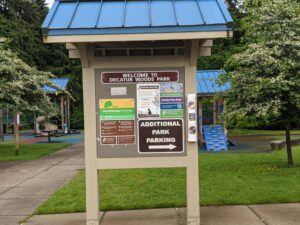
Your mission is to list two short facts about porous pavement OR to count the individual native tree and plant species found along the trail and send us your tally!
Decatur Woods Park is a 6-acre forested park in the heart of Olympia’s southwest residential area. Having both a playground area and a paved trail through a second growth forest. This small park has a remarkable showcase of native trees and shrubs.
Also, you will find groundbreaking science at work as the stormwater treatment in this neighborhood is built to mimic a natural water cycle and infiltrate stormwater into the ground below.
This park has entrances on Decatur Street SW and 11th Ave SW.
 City of Olympia Decatur Street Low Impact Development (LID) Stormwater Project
City of Olympia Decatur Street Low Impact Development (LID) Stormwater Project
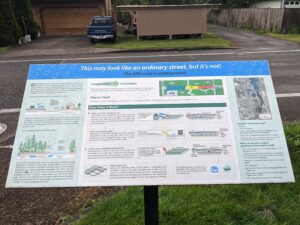
Did you know that stormwater is the #1 pollutant of our streams and Puget Sound?
Stormwater is rain and snow melt that runs off hard surfaces like streets, roofs, parking lots and highways. As it flows over these surfaces it picks up pollution like oil, fertilizers, pesticides, dirt, trash, and animal waste, such as dog poo. These pollutants then flow into our streams and Puget Sound untreated, contaminating the water. Most stormwater drains are untreated and flow directly to a stream, wetland, or Puget Sound.
Why does it matter? Before the land was developed, clean rain and snow would fall onto trees, shrubs and the ground, soaking into the ground. Development and people mean more hard, unnatural surfaces where the rain cannot soak into the ground. It also means more stormwater with collected flowing down streets and off roofs into a storm drain that leads to streams, lakes, wetlands or Puget Sound, untreated.
Stormwater:
- Is toxic to fish and damages salmon habitat
- Pollutes beaches and shellfish beds
- Contaminates groundwater that we use for drinking
- Contaminates swimming areas
- Contributes to flooding
- Degrades or contaminates water quality
In 2008, the City of Olympia completed the installation of three designs to capture and clean stormwater in this neighborhood.
On Decatur Street these three stormwater treatments were installed:
- Stormwater catch basins with filters and perforated pipe (or a pipe with holes so water can soak in or out) to capture and treat the stormwater.
- Porous (meaning water can soak through) pavement was installed so that water would infiltrate or soak into the ground.
- Rain gardens were installed to receive stormwater and infiltrate or soak into the ground.
To learn more, read the large sign near the Decatur Park entrance!
Stormwater is a people problem and only people can solve it. The more people we have, the more dog poo and more cars dripping oil and other contaminants creating more harmful stormwater.
What can you do to help stormwater?
- Practice natural lawn care and plant native plants.
- Fix car leaks, use a commercial car wash and keep tires properly inflated.
- Pick up and dispose of pet waste.
Comprehensive LID project information.
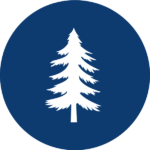 Woodland Walk
Woodland Walk
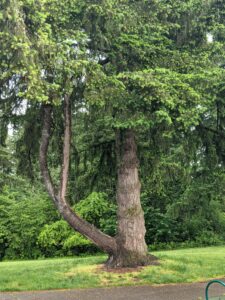
Go through the playground area and follow the paved trail on your right.
Can you find the Douglas fir that looks like it has an arm? Is it a limb or another trunk? It is a second and third trunk!
Like most conifers Douglas fir trees grow with a central leader or trunk. A tree that has been damaged while young (maybe a deer ate the top off and it grew another?) may have more than one leader which can be a weak point creating a possible area for a future break.
Did you know a Douglas fir tree can grow to be over 200 feet tall? Historically they grew to be 400 feet, taller than a redwood tree!
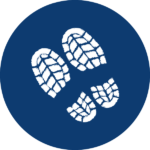 Parking Lots & Storm Drains
Parking Lots & Storm Drains
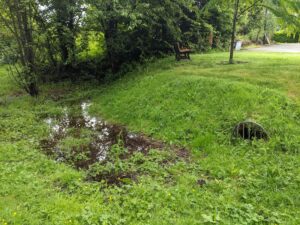
Can you find the grated storm drain that leads to the neighboring parking lot?
This pipe connects to the neighboring parking area and when it rains the rain, which is now stormwater, washes off the pavement and flows through the pipe emptying into the park, creating a wet area. During heavy rains when the soil is saturated, or filled with water, you will find a small pool of open water. Eventually the water soaks into the ground filtering the stormwater.
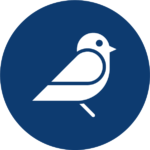 Wildlife Habitat
Wildlife Habitat
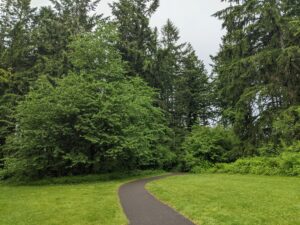
As you walk along the trail, locate homes for wildlife in the forest.
Can you solve this riddle – Have you seen or heard me? I came to Washington state in the early 1900’s and mostly live in urban areas. I look similar to my cousins except I am mostly gray with a white belly. I love to eat hazelnuts and hide them in the grass for winter. Often, I forget where I hid them, and a new tree can grow from the hazelnut seed. I make my nest of leaves high up in the trees and if I you come to close, I will chatter at you. Who am I? An Eastern gray squirrel!
What other small mammals do you think live here? Can you find the round mound of dirt with a hole in the middle? Who made this? A Townsend mole!
Moles spend almost their entire lives underground and have small, weak eyes, and small hips for turning around in tight places. They have a luscious velvety fur that is reversible to make backing up easy. They have broad front feet, their toes form a claw face outward for digging. Moles eat mostly insects and other invertebrates, or animals without a backbone such as earthworms.
Moles are greatly misunderstood and disliked as they dig their holes making round dirt mounds in places that once was mole habitat but now has been developed by humans. They cause no harm, and it is often impractical to try and exterminate them as others will take their place. Visit this website to see how you can more easily live with moles.
 Native Trees and Shrubs
Native Trees and Shrubs
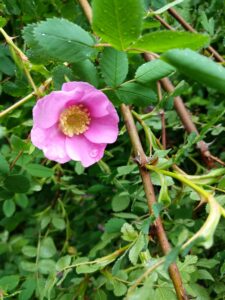
This small park of second growth forest has many different native trees and shrubs.
Can you find the small groves of the following trees and shrubs?
- Black cottonwood
- Nootka rose
- Bitter cherry
- Salal
Many of these shrubs have fruit that provide food for wildlife.
Can you name a few animals that like to eat woodland berries?
Stellar jays and coyotes do!
Remember to keep count of all the native trees and shrubs and send your tally to us!
 Coastal Temperate Rain Forest
Coastal Temperate Rain Forest
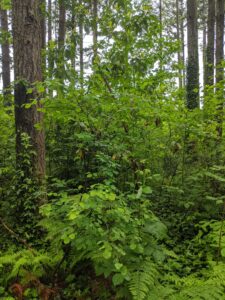
Olympia and the greater Thurston County is part of one of the rarest forest types, the coastal temperate rain forest.
Three features are common to all coastal temperate rain forests: 1) the presence of mountains, 2) being close to the ocean and 3) high rainfall.
The plants growing in the forest grow in different strata or levels and are adapted to the conditions found in the geographical area. The tall trees occupy the upper canopy, shrubs, and small trees the understory, and grasses and small plant make up the ground cover layer.
The dominant tree species for western North America’s temperate rain forest is Western red cedar, Sitka spruce, and Western hemlock.
One characteristics of these forests is that trees are shallow rooted and can easily blow down in intense windstorms. Trees of the temperate rain forest have no need for deep roots as the soils provide high nutrient content and plenty of moisture.
Fallen trees are essential for a healthy forest ecosystem. Decayed trees add nutrients to the soil. The Western red cedar provides a nutrient rich ‘nursery” as nurse logs or stumps for the seeds of trees and plants and they also provide homes for wildlife.
How many species can you think of that may live in a coastal temperate rain forest?
It has been stated that the coastal temperate rain forests of North America, have at least 350 bird and animal species, 48 species of amphibians and reptiles, thousands of insects, mites and spiders and hundreds of fungi and lichen species. Researchers are still discovering new insects in the far upper reaches of the tree canopy, and these forests are thought to support the most lichen and fungus types of any forest system. What an amazing place we live in!
Which native tree species can you identify along the trail? Any fallen trees or nurse logs or stumps?
 The Forest Understory
The Forest Understory
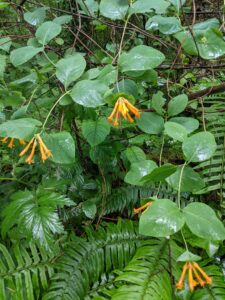
The plants growing under the tall rainforest trees have also adapted to the specific soil conditions and heavy rainfall.
See if you can identify the following native understory shrubs along the trail. If you are coming in spring, you may be in luck to see the orange trumpet flowers of the native honeysuckle. Remember to also be on the lookout for hummingbirds!
- Trumpet honeysuckle
- Beaked hazelnut
- Snowberry
- Red huckleberry
- Indian plum
- Red flowering current
- Vine maple
- Ocean spray
- Oregon grape
- Western mountain ash
 Invasive and Noxious Weeds
Invasive and Noxious Weeds
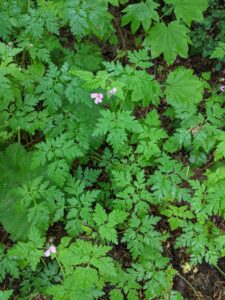
Most places where humans have interacted or dwell you will find invasive plants. These plants are not native to the area, they have been introduced from elsewhere and frequently from other countries. Once these plants are established, they grow fast, out competing the slower growing native plants, and are difficult to control. Some invasive plants are toxic or a public health threat to humans and animals, and others destroy native and beneficial plant communities.
Below are a few invasive weeds you can find along the trail.
What can you do to help eliminate invasive weeds?
- Never dump lawn waste or weeds into natural areas or storm ponds.
- Bag and trash invasive weeds.
- Never put invasive weeds into the yard waste bin, compost pile or drop off site.
- Clean and wash your mower if you mow invasive plants so that they do not spread through your yard and lawn.
- Do not purchase commercial wildflower seeds. Most commercial wildflower seeds contain fast growing, flowering invasive weeds.
To help protect the state’s resources and environment, the Washington State Weed Board adopts a state weed list each year. Learn more here.
For in-depth information on weed identification, removal and disposal visit:
 Born Learning Trail
Born Learning Trail
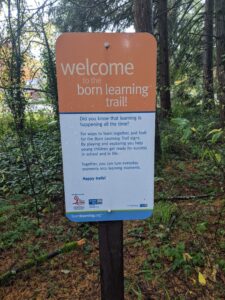
Find the signs for the Born Learning Trail for an exploratory sensory experience for young adventurers.
You may also try quiet activities to enhance your experience and open your powers of observation. Sit quietly in one place and open your senses. What do you hear, see, smell? Now try it closing your eyes!
 Congratulations!
Congratulations!
You have completed your mission to list two short facts about porous pavement OR to count the individual native tree and plant species found along the trail and send us your tally! Don’t forget to log in to the Goose Chase App and submit your findings for this mission to collect your park specific sticker!
